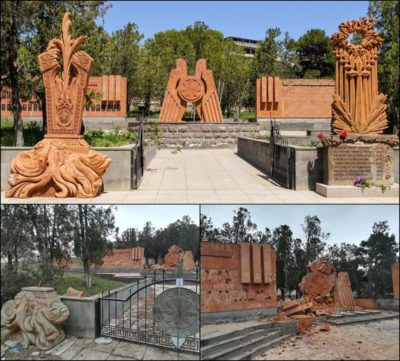The agreement on the terms of a peace treaty between Azerbaijan and Armenia includes Armenia’s potential withdrawal from the international legal proceedings at the International Court of Justice and at the European Court of Human Rights. it was announced on March 13, 2025. I have already elaborated on the negative consequences over the right of return of Artsakh people if it materializes. The agreement is silent on other aspects of Nagorno-Karabakh case, including the fate of prisoners and the protection of Artsakh cultural heritage.
There are many reports detailing the destruction of cultural monuments by Azerbaijan since its resumption of control over the Nagorno-Karabakh (“Artsakh” in Armenian) oblast after the forced displacement of its population. We are witnessing a systematic destruction of Armenian cultural and historical heritage. The intention to erase all traces of Armenian civilization is obvious and has been denounced around the world.
Armenian diplomatic circles raised this issue during the interministerial conference of the Forum of Ancient Civilizations on the sidelines of the United Nations General Assembly in September 2024. UNESCO, an organization within the UN that has never been noted for its effectiveness, initially adopted a neutral position during the 2020 conflict, then expressed concerns and finally declared in February 2022 its intention to send a mission of experts, provided that both Armenia and Azerbaijan agree on the mission. Azerbaijan has not responded, and therefore no mission has been established. The destruction continues: the press regularly reports about it and the Center For Truth and Justice published a report. Caucasus Heritage Watch, an entity affiliated with Cornell University, monitors and documents threatened and damaged cultural heritage using high-resolution satellite imagery. They reveal visual evidence of past and present cultural erasure using the latest Earth observation technologies.
On the political front, the European Parliament Resolution on the Destruction of Cultural Heritage in Nagorno-Karabakh of March 10, 2022, is a landmark document, the most comprehensive ever adopted on the issue of threatened cultural heritage. The resolution strongly condemns Azerbaijan’s policy of erasing and denying Armenian cultural heritage in and around Nagorno-Karabakh, in violation of international law. It notes that the erasure of Armenian cultural heritage is part of a broader state policy of systematic Armenophobia, historical revisionism and engendering hatred against Armenians promoted by the Azerbaijani authorities, including through dehumanization, glorification of violence and territorial claims against the Republic of Armenia, which threaten peace and security in the South Caucasus. It stresses that cultural heritage has a universal dimension as evidence of history inseparable from the identity of peoples and the need to address the protection of historical and cultural heritage in the broader context of the resolution of the conflict between Armenia and Azerbaijan and the final determination of the status of Nagorno-Karabakh.
This being said, it is appropriate to examine the legal issues that arise regarding the protection of cultural heritage and the repression of acts of destruction in the light of the recent official announcements that the terms of the peace treaty between Azerbaijan and Armenia are agreed upon.
What are the legal instruments applicable? Who are the victims, and what remedies are available? Does Armenia not already have a solid legal basis and a judicial mechanism in place to hold Azerbaijan responsible?












